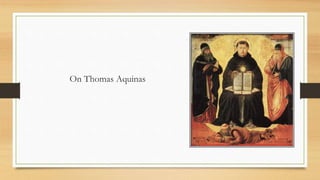
On Thomas Aquinas
- 2. Does God Exist? • The question of whether God exists is an important philosophical question, since it impacts our understanding of the world and appears to have moral implications. • However, despite such apparent moral implications, it is not a question in ethics, but in metaphysics. The question of whether we can know if God exists is a question in epistemology.
- 3. • These questions have been debated since nearly the beginning of the history of philosophy.
- 4. Bio • Thomas Aquinas (1225-1274) was a prolific Roman Catholic theologian and Dominican monk living and writing during the 13th century (i.e., in the high middle ages). • He was canonized by the Catholic Church about half a century after his death (i.e., in 1323).
- 5. • Aquinas’ theology sought to synthesize reason (essentially, the philosophy of the ancient Greek philosopher Aristotle) with faith (Catholic doctrine).
- 6. The Summa Theologica • The paragraph by Aquinas assigned for reading is taken from his final major work, the Summa Theologica. • Near the beginning of the Summa Theologica, he offers his famous “Five Ways.”
- 7. • Each of the “Five Ways” is an argument that tries to prove God’s existence, in a distinct way, from observations of the natural world. • Rather than leaving the question of God’s existence to just faith, he thought that each of his “Five Ways” was a legitimate way to seek to convince a non- believer of the existence of God.
- 8. • Aquinas sees such an effort as consistent with Scripture: • “The invisible things of Him are clearly seen, being understood by the things that are made” (“Romans” 1:20)1.
- 9. • In this course, we will consider only the fifth of Aquinas’ “Five Ways.” This “fifth way” is called the “Argument from Design,” and is contained in the paragraph by Aquinas assigned for reading. • The “fifth way” was selected for this course in part because it is, perhaps, the most influential of the “Five Ways.”
- 10. On the Argument from Design • Notice that the first premise in the Argument from Design refers to “natural bodies” as things that lack intelligence but which act for ends (i.e., for goals).
- 11. • Examples of such “natural bodies” are: • Plants, such as trees, which lack intelligence but pursue goals, such as growth and reproduction • Organs, such as a heart or lungs, which lack intelligence but pursue goals (i.e., functions such as blood circulation or respiration)
- 12. • Note that the “natural bodies” referred to by the Argument from Design clearly are NOT humans, since a human has his/her own intelligence to pursue his/her goals. • Failing to recognize this will result in a lack of understanding and a “straw man” (i.e., a misrepresentation) of the Argument from Design.
- 13. • In the Argument from Design, the observable existence of such non-intelligent “natural bodies,” such as trees, pursuing goals, is the key to proving the existence of an intelligent being (God) who directs these non-intelligent natural bodies to their ends (i.e., goals).
- 14. • The Argument from Design can be presented in enumerated form as follows.
- 15. 1. We see that non-intelligent things (e.g., natural bodies) always or for the most part work toward some end, i.e., goal. 2. So, natural bodies reach their end, not by chance, but by design. (From 1) 3. An arrow is shot to its target by an archer. 4. So, whatever lacks intelligence similarly cannot move toward a goal unless it is directed by some being with intelligence. (From 3) 5. Therefore some intelligent being exists by whom all natural bodies are directed to their end; and this being we call God. (From 2 and 4)
- 16. • Notice the parenthetical notes after Premises 2 and 4, and the Conclusion (5). Each of these parenthetical notes indicates the prior premises from which the statement is derived, and together, they should help you see the internal logic of the argument.
- 17. • Premises 3 and 4 together constitute the “archer analogy” in the Argument from Design.
- 18. • If you follow the internal logic of the Argument from Design, it should be clear that the arrow mentioned by Premise 3 is intended to be analogous to the non-intelligent natural bodies (such as trees or hearts). • The arrow moves toward a goal (in its case, a target), just as “natural bodies” move toward goals. Moreover, both the arrow and the natural bodies are non-intelligent. • As a result, both the arrow and the natural bodies depend on another, intelligent being to direct them to their goals. In the case of the arrow, that being is the archer. In the case of the natural bodies, that being is the one mentioned by the Conclusion (5): God.
- 19. Is Evolution a Refutation? • Some may object that the Argument from Design is “outdated” on the ground that the modern theory of evolution offers a scientifically proved, alternative way to explain the goal-directedness of non-intelligent bodies, such as trees and lungs.
- 20. • However, notice that the Argument from Design says nothing about the means by which God directs non-intelligent natural bodies to their goals. It neither affirms nor denies the modern theory of evolution (which Aquinas could not have known about). • Thus, there is no inconsistency between the Argument from Design and the modern theory of evolution.
- 21. • One can accept the Argument from Design, and take biological evolution and genetics to be the means by which God directs non-intelligent natural bodies (such as trees or lungs) toward their ends (i.e., goals). There is no inconsistency in that.
- 22. Endnotes 1. Quoted in Thomas Aquinas, Summa Theologica I.2., trans. Fathers of the Dominican Province (URL: http://www.sacred- texts.com/chr/aquinas/summa/sum005.htm, accessed on 5/15/18).